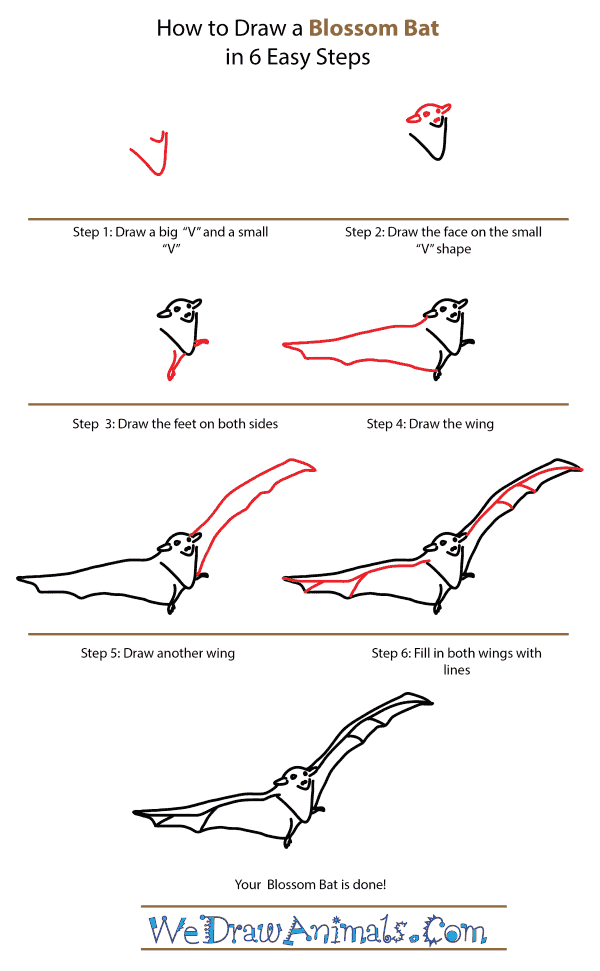In this quick tutorial you'll learn how to draw a Blossom Bat in 6 easy steps - great for kids and novice artists.
The images above represent how your finished drawing is going to look and the steps involved.
Below are the individual steps - you can click on each one for a High Resolution printable PDF version.
At the bottom you can read some interesting facts about the Blossom Bat.
Make sure you also check out any of the hundreds of drawing tutorials grouped by category.
How to Draw a Blossom Bat - Step-by-Step Tutorial
Step 1: Draw a big "V" to create the Bat's chest, and a smaller "v" at the top of the chest for its chin
Step 2: He needs to see and hear right? Use a half circle and more triangles to complete the face and head
Step 3: At the bottom of the big "V", draw a leg on both sides where it comes to a point.
Step 4: Draw a skinny triangle on the left to create a wing
Step 5: Do the same again on the right side
Step 6: Add lines to the wings to simulate webbing
Interesting Facts about the Blossom Bat
The blossom bat, also called the Queensland blossom bat, is considered of the mega-bat variety despite is small size of six centimeters. Its smile size and narrow, angular face makes it easy for this flying animal to feed off its preferred source of food-flowers, where they extract nectar and pollen for sustenance. They are the smallest of all the fruit bats, and have a long tongue with a brush-like tip that helps them to obtain nourishment from area flowers. Usually the blossom bat will land on flowers to feed, but they may also simply hover in front of the flower and use their long tongues to feed from it without actually landing on it. The blossom bat is an incredibly important pollinator of the rain forests where they live and roost daily.
Did you know?
- The blossom bat is indigenous only to Australia.
- They roost in the canopies of trees, and are one of the few species of bats that roost every single day.
- Whenever food is scarce, usually due to human intervention in their habitat, the blossom bat can go into a torpor (or hibernation of sorts) to preserve its energy.
- They are a mostly harmless species of bat with little interest in humans at all, but they can carry a disease known as Australian Bat Cissavirus, which transmits via biting or scratching. This, however, is a rare occurrence.
- When the young bats are born, one is usually born to its mother in early spring, with a sibling usually following in early autumn or late summer.
Arts and Crafts Activity Notes: First, obtain flowers. These can be fake or real, but make sure there are enough for each participant to have one. Next, draw the blossom bat and make copies for each participant, then distribute them. Have each person color their bat with markers, colored pencils or crayons, and then carefully cut them out with safety scissors. They can then use pipe cleaners, likely cut down to small size and in a color that matches the flower, to fix their bat to the petals with tape or glue. And now each person will have their own blossom bat, feeding and ready to help pollinate the forest!







